City guides


Glasgow Travel Guide
During the past few decades Glasgow, the UK's fourth largest city, has re-invented itself from a rather economically depressed industrial centre to an interesting modern metropolis with a thriving arts and culture scene, which has earned it accolades like the 'European City of Culture' title in 1990, 'City of Architecture' in 1999 and the 'UNESCO City of Music' in 2008.
In days of yore Glasgow depended on shipbuilding and engineering for its wealth; the city fell into decline in the mid-20th century with massive poverty and unemployment. Prosperity has returned however, riding on the back of 21st century technology, and Glasgow is now the hub of Scottish film, theatre, writing, music and design, capturing worldwide attention.
The city has more than 20 galleries and museums to complement the architectural heritage of architects like Alexander Thomson, renowned for his classical designs, and Charles Rennie Mackintosh, master of Art Nouveau.
The youthful, progressive atmosphere of the reborn Glasgow is encouraged by its large student population, which is spawned by four universities and several colleges, and reflected in the numerous lively restaurants, pubs and attractive shopping precincts.
Tourists find plenty to see and do in Glasgow, and can also use it as a base to explore the surrounding countryside, boasting some of Scotland's most scenic mountains, glens, lochs and coastline.
Things to do in Glasgow
With lovely parks, an abundance of museums and galleries, excellent shopping, and a lively music scene, your holiday in Glasgow won't be short of entertainment. Glasgow is a young city, with a lot of energy, and sightseeing attractions compete with pubs, bars, malls and restaurants for the attention of visitors. Music enthusiasts, football fans and party animals will be as happy in the city as culture vultures.
There is a wealth of galleries and museums in Glasgow, with the best of them including the Burrell Collection, housed in the lovely Burrell Park, and the Gallery of Modern Art (GoMA), which challenges visitors with its impressive variety. Kelvingrove Art Gallery and Museum, Glasgow's principal art gallery and museum, and the fascinating Hunterian Museum, Scotland's oldest public museum are undoubtedly worth a visit. A Glasgow attraction which delights visitors interested in architecture is the Glasgow School of Art, a famous building designed by Charles Rennie Mackintosh, which can be explored on a guided tour lead by a student of the institution. The Glasgow Science Centre is another great favourite with tourists, as is the beautiful, 12th-century Glasgow Cathedral.
Sightseeing in Glasgow is a joy, particularly as so many of the museums and galleries have free entrance.
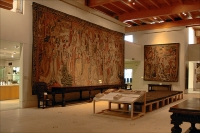
Burrell Collection
Glasgow's top cultural attraction was donated by the shipping magnate Sir William Burrell in 1944. Over his lifetime, Burrell amassed more than 8,000 works of art. The collection includes hundreds of sculptures, drawings and paintings from the 15th century to the present, some notable medieval European tapestries, as well as artefacts from Arabia and the Orient. The collection is housed in a functional, purpose-built building set in the sedate surroundings of Pollok Country Park.
Although it may seem unassuming, the building was meticulously designed to showcase the collection and complement the natural landscape. Within walking distance of The Burrell is Pollok House, which contains a fine collection of Spanish paintings including works by Goya, Murillo and El Greco. The Edwardian house is the ancestral home of the Maxwell family, who donated the house and the collection to the National Trust in 1966.
Currently undergoing extensive renovations, the Burrel Collection is set to reopen in 2020. The changes to the museum will increase its floor space fourfold, allowing 90% of Burrel's collection to be on display at any given time.
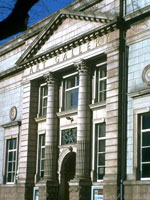
Gallery of Modern Art
Located in a former Grecian-style mansion near George Square and Buchanan Street, the Gallery of Modern Art (GoMA) displays Glasgow's extraordinary range of post-war art and design. Opened in 1996, the gallery includes works by Niki de Saint Phalle, David Hockney, Sebastiao Salgado, Andy Warhol and Eduard Bersudsky as well as Scottish artists such as John Bellany and Ken Curry. GoMA is Scotland's most visited modern art gallery, and is conveniently located in Royal Exchange Square, in the heart of the city.
The permanent collection tends to divide visitors, with hugely varied reviews of the museum from tourists, with some visitors finding it fascinating, inspiring and edgy, while others lament the lack of 'real art'. The statue of the Duke of Wellington with a traffic cone on its head, just outside the museum, has become rather iconic. There is free internet access in the museum and an impressive library, with an extensive collection of art and design books and a simple cafe. The gallery hosts special events and exhibitions throughout the year; check the official website to see what is on during your visit.
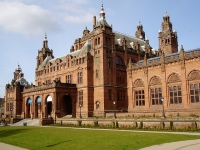
Kelvingrove Art Gallery and Museum
Glasgow's principal art gallery and museum, the Kelvingrove is one of Scotland's most popular free attractions. This imposing red sandstone building, opened in 1901, houses a superb collection of paintings by old masters such as Botticelli, Rembrandt, Monet, Van Gogh and Picasso, as well as an impressive display of European armour, military weapons and prehistoric relics. There are 22 themed galleries containing an incredible 8,000 artefacts and objects from all over the world and covering extremely wide-ranging interests and subjects, ensuring that every visitor should be able to find something that genuinely interests them in the museum.
For many people, the main attraction of the permanent collection is a room dedicated to the works of the 19th-century architect Charles Rennie Mackintosh, who studied at the Glasgow School of Art and designed many of the city's great Art Nouveau buildings. The museum also hosts regular temporary exhibitions, for which visitors are usually charged a small entrance fee. There is a pleasant restaurant at the museum, and a shop for souvenirs. Kelvingrove is one of the top attractions in the city and generally receives rave reviews from tourists.
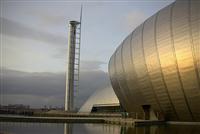
Glasgow Science Centre
One of the city's premier tourist spots, the Glasgow Science Centre is a captivating attraction that will appeal to visitors of all ages. Located in Glasgow's Clyde Waterfront Regeneration area, the Science Centre has been awarded a five-star ranking from VisitScotland, the country's official tourist board. There is much to see and do in the Glasgow Science Centre. The heart of the Centre is its Science Mall, which features hundreds of interactive exhibits spread over three floors.
The Science Mall includes fun, hands-on experiences focused on how the body works, perception and illusion, powering the future and quantum technologies, to name a few. The Glasgow Science Centre is also home to an IMAX theatre and Scotland's leading planetarium. A world-class attraction, a trip to the Glasgow Science Centre is a must for visitors to this Scottish city, and an absolute godsend for those travelling with kids. Put aside at least three or four hours to take it all in.
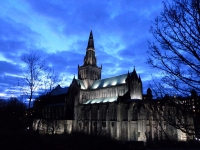
Glasgow Cathedral
The history of the city of Glasgow is intimately linked to that of the Glasgow Cathedral, as it was the city's patron saint, St Mungo, who oversaw its original construction. The Saint's remains are buried in the cathedral's crypt, and the cathedral itself continues to form a vital part of the religious life of the city of Glasgow. The church has now been in constant use as a place of worship for a remarkable 800 years and its age is palpable. The cathedral's age is all the more remarkable considering how many of Scotland's churches were destroyed during the Reformation.
The impressive medieval building, which dates back to the late 12th century, is one of the best examples of Scottish Gothic architecture you'll find anywhere in the country, featuring vaulted arches, stained glass, and spires that have been beautifully blackened with age. A highly recommended activity for tourists in Glasgow, take about an hour to explore the Cathedral's quiet, serene and splendid interior. Guide books in English, French, German, Italian and Spanish are available at the cathedral and simple leaflets are available in 12 different languages. Guided tours can be arranged, although this service is more limited in the winter months.
Eating Out
As the city gradually becomes more cosmopolitan, the restaurants in Glasgow follow suit. The home city of celebrity chef Gordon Ramsay, Glasgow seems to be growing into a reputable gastronomic destination. Plenty of good options can be found when looking for places to eat in Glasgow, a city where young chefs are redefining Scottish cuisine and travellers can find a comprehensive offering of enticing international eateries.
Interestingly, Glasgow has been named the 'Curry Capital of Britain', and you'll find a number of good Indian restaurants catering for all budgets, as well as the ubiquitous fish and chips takeaways. Glasgow is home to large immigrant populations, so there are tasty restaurants that serve Greek, Korean, Lebanese, Spanish, Japanese, and Turkish cuisine in addition to the usual Chinese, Italian and Thai options. This variety is one of the main delights of eating out in Glasgow, but there are also plenty of restaurants serving traditional Scottish grub.
The West End is packed with pubs, bars and restaurants, and The Merchant City district is also a great place to find trendy restaurants.
Many Glasgow restaurants close for either Sunday or Monday. Diners are expected to tip wait staff around 10 percent, or 15 to 20 percent for very good service. Smoking is prohibited in all restaurants and bars in Scotland and hefty fines await those breaking the law.
Shopping
Shopping in Glasgow is one of the best-kept secrets in Europe. The city is second only to London for the most retail space in the UK, and attracts dedicated shoppers from all over the country.
The heart of the Glasgow shopping districts is the 'Golden Z', which zigzags through the city centre along the pedestrian malls of Argyle, Buchanan and Sauchiehall streets. Here you'll find all the major European brand names, with Buchanan Street and its mall the Buchanan Galleries attracting the most upmarket shops. The Argyle Arcade has a large concentration of jewellery shops, and Princes Square is a stylish centre set in a renovated Victorian building.
If chain stores aren't your fancy, nearby Bath Street and Hope Street are home to a number of independent shops and boutiques where you can find a unique Glasgow souvenir or gift. De Courcy's Arcade has a fun variety of book and music stores, and a few quirky independent gift shops. Popular Glasgow souvenirs include wool knits like cashmere sweaters, mittens and scarves; swirling paperweights of Caithness glass; and local food like smoked salmon and shortbread cookies.
There are also city centre markets that are well worth a visit, including the Barras in the East End, which boasts hundreds of market stalls selling all manner of items. Be wary of counterfeit goods however, as the market is rife with knock-offs and pirated goods.
There are a few popular shopping malls in Glasgow, mostly on the periphery of the city. The biggest and busiest can be found in Braehead, Silverburn and Glasgow Fort.
Shops in Glasgow are generally open from 9am to 6pm Monday to Saturday, closing later (8pm) on Thursday evenings. The shops in the outer parts of the city may be open slightly later, and more and more stores are opening on Sunday afternoons.
Getting Around
Glasgow's city centre is compact and easily explored on foot, but public transport will be needed to reach some of the major attractions, which are farther out. The integrated transport network includes a reliable but confusing bus system with connections to the underground and train network. Some routes operate limited services throughout the night. The simple underground system, also known as the Clockwork Orange, has two circular routes that are easy to understand; this is the best way to get between the city centre and the West End. The suburban train network is fast and efficient. Taxis are readily available and provide excellent, if fairly expensive, service. A car is not necessary in the centre, and it is often easier to get around using public transport. Car users can make use of the park-and-ride system at underground stations outside the city centre.
Glasgow Climate and Weather
Like the rest of Scotland, the weather in Glasgow is unpredictable and several degrees colder than England in the south of the British Isles. Winters (December to February) are long and wet, with very cold winds and some snow, and average temperatures ranging from 35°F (2°C) to 45°F (7°C) with seldom a sign of the sun. However, when spring arrives (between March and May) the mild temperatures and colourful flowers in parks and gardens make the city a cheerful place to be. In summer (June to August) most days start off misty but warm up to sunny, mild afternoons, with an average high of 67°F (19°C) in the height of summer.
United Kingdom travel info
Electricity
The electrical current in the UK is 240 volts, 50Hz. Flat, three-pin plugs are standard.
Language
English is the official language, though visitors will be astonished by the variety of regional accents.
Money
The currency is the British pound (GBP), which is divided into 100 pence. ATMs are available in almost all towns and Visa, MasterCard and American Express are widely accepted. Foreign currency can be exchanged at bureaux de change and large hotels, though better exchange rates are likely to be found at banks.
Tipping
Tips of 10 to 15 percent are expected in restaurants and upmarket hotels in the UK if a service charge hasn't been included. Hotel service staff receive an optional amount, while taxi drivers are usually given 10 to 15 percent of the fare. Tipping bartenders isn't expected, and tipping for other services is discretionary.
Health
There are no specific health risks associated with travel to the UK and food and water can be considered safe. The British National Health Service is excellent, and a number of countries have reciprocal health agreements with the UK including Australia, New Zealand and EU countries. Visitors from other countries such as Canada, South Africa and the United States are advised to take out comprehensive travel insurance.
Safety
It's generally safe to travel throughout the UK.
Local customs
Handshaking is customary when introduced to someone new. Smoking is banned in all enclosed public spaces, including pubs, restaurants and public transport. Queue barging is frowned upon and there is strict etiquette on escalators: stand on the right, walk on the left. Visitors may find Londoners more rushed and less friendly than locals in other parts of the country, particularly on London transport, where tourists are often the only people who talk.
Doing business
The four countries of the United Kingdom, although culturally and historically different, generally keep to the same business practices. Politeness and punctuality are key to good business relations and initial meetings are often conducted formally and impersonally, becoming more open and social as things progress. Business cards are exchanged at introductions, and dress is formal with dark suits preferred. Business hours are generally 8am to 5pm Monday to Friday with an hour taken at lunch.
The communication style can be difficult to adjust to: the British people respect politeness to a point that often obscures their ability to say exactly what they mean. As a result, travelling business people may need to learn to 'read between the lines' and to take cues from tone of voice and facial expression. Humour is also an integral part of the British system of communication, and is used to diffuse a tense situation and to cultivate relationships. Foreigners should never assume that an attempt at humour undermines a person's ability to do their job, or discredits the importance they attach to a deal or negotiation. Furthermore, they shouldn't be fooled into thinking that the British propensity for irony and sarcasm equates with an informal work environment.
Foreigners should be tactful during meetings, avoid becoming emotional and illustrate their experience with the subject at hand. Performance and initiative are looked upon favourably, whereas academic pretension is given far less credence. Meetings are often used as platforms for debate, rather than moments of confirmation, so there should be no surprise if not much progress is made. Foreigners should be sure to respect and appeal to all parties involved, as the British have recently begun to take a far flatter approach to management and the responsibility of decision-making. And if things go well, it's worth purchasing a pint or two for clients or colleagues; though gifts are borderline inappropriate, a round of drinks will rarely be refused.
Duty free
Travellers can bring the following goods into the UK tax or duty free: 200 cigarettes, 100 cigarillos, 50 cigars or 250g of tobacco, 18 litres of still table wine, 42 litres of beer, 4 litres of spirits or strong liqueurs or 9 litres of fortified wine, sparkling wine or other alcoholic beverages of less than 22 per cent volume.
Communications
The international country dialling code for the UK is +44. Mobile phone coverage is extensive and free WiFi is widely available in pubs and coffee shops. Travellers can purchase local prepaid SIM cards for unlocked phones or use eSIMs if their cellular providers support it on their networks.
Passport & Visa
If a visa is not required, travellers should hold a return or onward ticket, and proof of funds for the duration of stay. Passports must be valid for the period of intended stay in the UK. It's highly recommended that travellers' passports have at least six months' validity remaining after the intended date of departure from their travel destination. Immigration officials often apply different rules to those stated by travel agents and official sources. For visitors who are visa exempt up to a maximum stay of six months, the period of stay will be determined by the Immigration Officer on arrival.
Entry requirements
US travellers must hold a passport that is valid for the duration of their stay; a visa is not required for stays of up to six months.
Canadian passports must be valid for at least the expected duration of the stay. No visa is required for stays of six months or less.
Australian passports must be valid for at least six months after the departure date. No visa is required for stays of six months or less.
South Africans require a valid passport and a visa for entry or transit through the UK. South African temporary passports are not recognised.
Under the Common Travel Area agreement, citizens from the UK and Ireland are not required to pass through passport control. They can travel between both countries without a valid passport if they can prove they are a valid UK or Irish national.
New Zealand nationals must hold a valid passport, but no visa is required for stays of up to six months.
Useful contacts
United Kingdom Tourism Website: www.visitbritain.com
999 (General)Embassies / consulates in other countries
British Embassy, Washington DC, United States: +1 202 588 6500.
British High Commission, Ottawa, Canada: +1 613 237 1530.
British High Commission, Canberra, Australia: +61 2 6270 6666.
British High Commission, Pretoria, South Africa: +27 12 421 7500.
British Embassy, Dublin, Ireland: +353 1 205 3700.
British High Commission, Wellington, New Zealand: +64 4 924 2888.
Embassies / consulates in United Kingdom
United States Embassy, London: +44 20 7499 9000.
Canadian High Commission, London: +44 20 7004 6000.
Australian High Commission, London: +44 20 7379 4334.
South African High Commission, London: +44 20 7451 7299.
Irish Embassy, London: +44 20 7235 2171.
New Zealand High Commission, London: +44 20 7930 8422.


